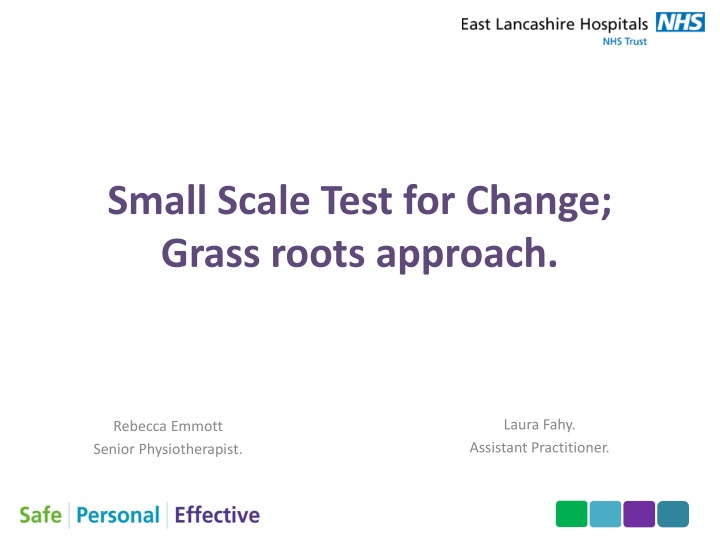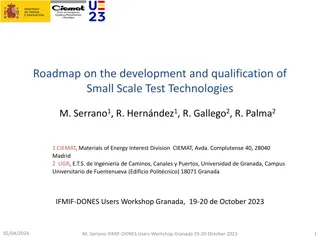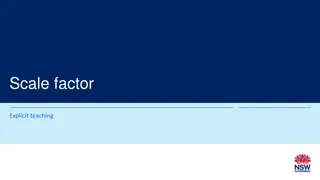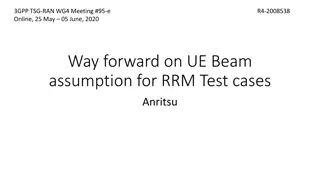
Grassroots Approach to Small Scale Test for Change in Healthcare System
Delve into a grassroots initiative led by Laura Fahy and Rebecca Emmott, focusing on implementing small-scale changes to address challenges in healthcare service delivery. Explore the use of the Plan, Do, Study, Act cycle and the Reablement with Therapy (RWT) program to enhance patient care and operational efficiency.
Download Presentation

Please find below an Image/Link to download the presentation.
The content on the website is provided AS IS for your information and personal use only. It may not be sold, licensed, or shared on other websites without obtaining consent from the author. If you encounter any issues during the download, it is possible that the publisher has removed the file from their server.
You are allowed to download the files provided on this website for personal or commercial use, subject to the condition that they are used lawfully. All files are the property of their respective owners.
The content on the website is provided AS IS for your information and personal use only. It may not be sold, licensed, or shared on other websites without obtaining consent from the author.
E N D
Presentation Transcript
Small Scale Test for Change; Grass roots approach. Laura Fahy. Assistant Practitioner. Rebecca Emmott Senior Physiotherapist.
Plan, Do, Study, Act (PDSA) cycle. Framework key questions: Model for Improvement 1.What are we tying to accomplish? 2.How do we know if the change is an improvement? 3.What changes can we make that will result in improvement.
Reablement with Therapy (RWT) Overview. A short and intensive therapy service delivered within the patients home. Offered to patients who are frail or recovering from illness or injury often to support safe hospital discharge. Commissioned by Lancashire County Council. Available for up to 6 weeks with maximum 4 visits per day.
Current pathway. S75 referral received from Lancashire County council. Referral triaged for Assistant Practitioner (AP) urgent. Referral placed on locality waiting list Patient seen by AP to complete initial assessment & set goals . Documentation entered onto EMIS & LAS - no home notes generated. Appointment made by admin team as appointment available. Patient reviewed weekly by AP (one hour slot) Patient reviewed over the next 6 weeks. Patient deemed not AP appropriate/ not meeting goals / requiring autonomous practitioner Patient assessed by B6 physiotherapist and reviewed as needed. Ongoing therapy need Patient referred to ITT. (RWT complete) All goals met Patient discharged. (RWT complete)
Is there a problem? Most RWT patients on waiting list breaching key performance indicator (KPI) of 5 working days. High wait time for all patients waiting to be seen by Rossendale Integrated therapy team. Most RWT patients outside of Therapy Assistant Practitioner (AP) scope of practice and requiring input from qualified physiotherapist.
Is there a problem? Inconsistent levels of communication between social and health sectors. Inconsistent levels of care between RWT patients. No standardised patient documentation. Therapy led service?
Primary aim. To ensure 100% of RWT Patients do not breech against the KPI by March 2019.
Secondary aims. To improve communication between social and health sectors. Improve satisfaction/outcomes for RWT patients. Improve effectiveness of support staff input by reducing waiting lists for support staff. Increase cost effectiveness.
Method and approach. STRENGTHS WEAKNESSES. Open to change. Lack of contacts within social care. Aware of the issues surrounding RWT. Other work / educational commitments. Motivated. Lack of knowledge of pathways/processes. Experienced. Good Communicators. Have links within the trust. OPPORTUNITIES. THREATS. Numerous changes to staffing within team. Shift in culture within NHS to actively promote change. Resistance from team / managers to implement change. Improved awareness around quality improvement processes. Time limits. Willingness from Social Services to be involved in change. Staff annual leave. Well placed as an AHP to work across organisational boundaries. Staff sickness. Numerous changes to staffing within team.
Who is involved? Single point of access (SPOA) Social services Physio/ TAP Private home care company Integrated therapy team Patient Quality Improvement team Operational managers Band 7 Clinical lead
Resources needed for test of change. Time. Clinical lead guidance. Knowledge of existing pathways. Patients & their families. Access to health & social services computer systems. Staff - Therapy staff - Admin - SPOA staff
Barriers to test of change. Time (again)! Resistance towards change. Multiple staff within therapy SPOA. Communication barriers between social and health sectors. Other work commitments.
Method and approach. Identification of need for RWT day 1x weekly. Identification of need for paperwork and goal sheets to be left in patients homes. Created new triage inbox for RWT patients. - CRG ( Care provider) - Senior Team leads/ Operational managers - Quality improvement team for therapies - Rossendale Integrated therapy team (ITT) Meetings - Single point of access (SPOA) - Admin - Social Services
Current pathway. S75 referral received from Lancashire County council. Referral triaged for Assistant Practitioner (AP) urgent. Referral placed on AP waiting list Patient seen by AP to complete initial assessment & set goals . Documentation entered onto EMIS & LAS no home notes generated. Appointment made by admin team when appointment available. Patient reviewed weekly by AP (one hour slot) Patient reviewed over the next 6 weeks. Patient deemed not AP appropriate/ not meeting goals / requiring autonomous practitioner Patient assessed by B6 physiotherapist and reviewed as needed. Ongoing therapy need Patient referred to ITT. (RWT complete) All goals met Patient discharged. (RWT complete)
New pathway. S75 referral received from Lancashire County council. Referral added to new RWT waiting list. Clinician contacts patient to arrange appointment . All RWT patients seen on same day to assess and set goals. Documentation entered onto EMIS & LAS Home notes left with patient. Patient reviewed twice in six weeks (determined by clinical need) care visits amended as required. Improved & regular communication between health clinicians and Social Services Ongoing therapy need Patient referred to ITT. (RWT complete) All goals met Patient discharged. (RWT complete)
Breech times during Test of Change: Before: Patient Breech time against KPI Total wait time (Not including weekends) Patient 1 Patient 2 Patient 3 Patient 4 Patient 5 4 days 5 days 8 days 6 days 11 days 9 days 10 days 13 days 11 days 16 day After: Patient Breech time against KPI Total wait time from referral received in SPOA (Not including weekends) 3 days 3 days 3 days 1 day 2 days Patient 1 Patient 2 Patient 3 Patient 4 Patient 5 No breech No breech No breech No breech No breech
Secondary aims. To improve communication between social and health sectors. Improve satisfaction/outcomes for RWT patients. Improve effectiveness of support staff input by reducing waiting lists for support staff. Increase cost effectiveness.






















